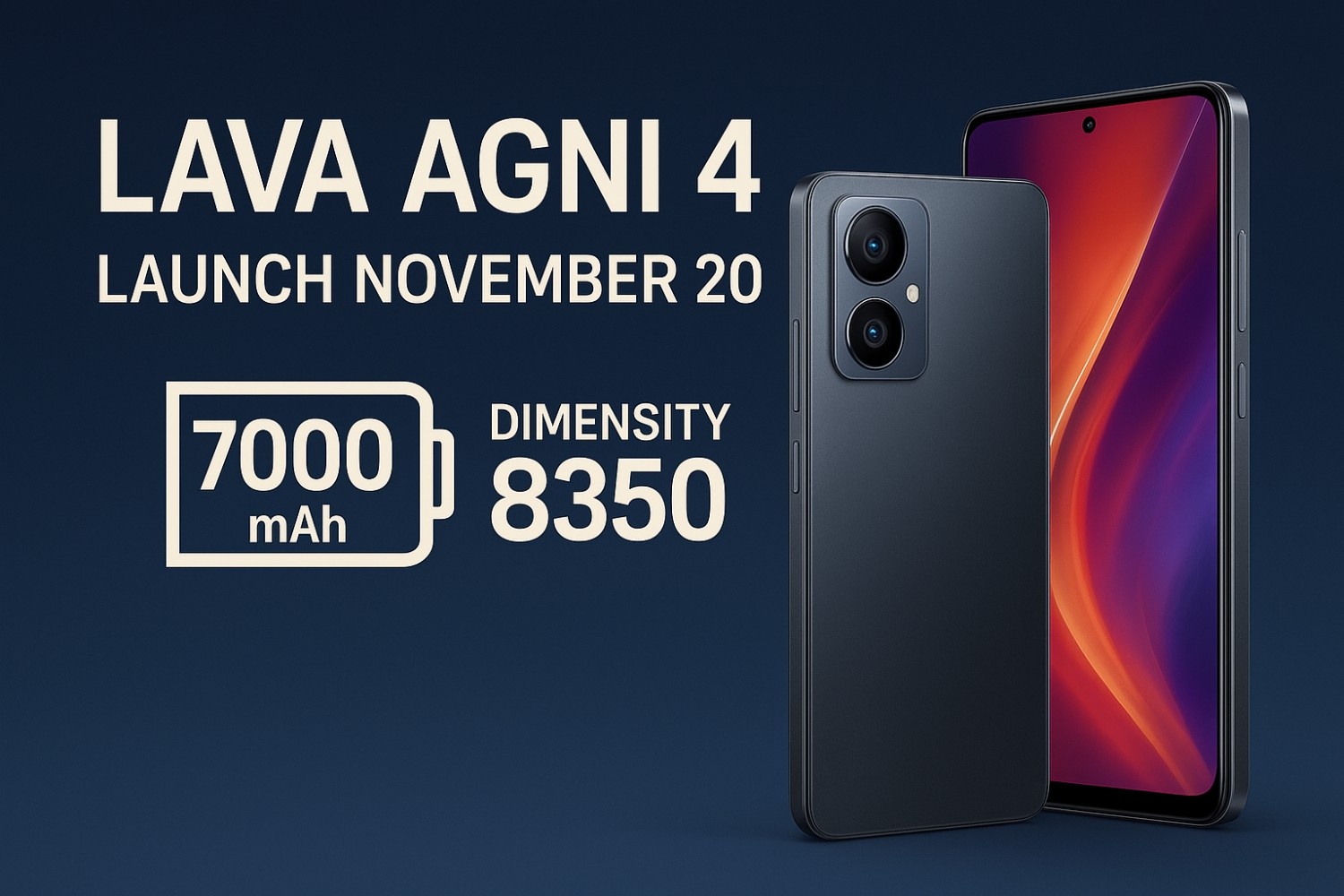Lava Agni 4 Set to Launch on November 20

Indian smartphone maker Lava has officially confirmed that its upcoming flagship mid-range handset, the Lava Agni 4, will launch on November 20, 2025 in India. The phone is shaping up as a serious contender in the sub-₹25,000 category with a 7,000 mAh battery, a MediaTek Dimensity 8350 chipset and a premium metal-frame build—features that matter for performance, endurance and build quality.
Background / Context
Lava’s “Agni” series was introduced as a “Made in India” push into premium or near-premium segments, with the previous model, the Lava Agni 3 5G, debuting in October 2024 and priced at around ₹20,999 for the base variant.
In the highly competitive Indian mid-range smartphone market, buyers seek a mix of strong specs (5G, large battery, high refresh display) and trusted local support. Lava aiming to notch up both performance and build quality with Agni 4 reflects how the market is evolving: premium materials + high value at moderate price.
Key Developments / Details
Launch date: Lava has confirmed November 20, 2025 as the launch date for the Agni 4.
Chipset: Leaked and teased data point to a MediaTek Dimensity 8350 chip (4 nm process) powering the handset.
Battery & build: Certification listing hints at a 7,000 mAh+ battery, which is a major jump from the Agni 3’s 5,000 mAh pack. Render leaks show the phone will feature a metal (aluminium) frame and flat edges for a more premium feel.
Display & camera: The phone is expected to sport a 6.78-inch (or 6.67-inch per one leak) Full HD+ display with a 120 Hz refresh rate.
Pricing: While not yet formally announced, the Agni 4 is expected to be priced under ₹25,000 in India. One estimate puts the starting price around ₹24,990.
Technical Explanation
Here’s a breakdown in simpler terms:
Dimensity 8350 chip: This is a 4nm class processor which means it consumes less power and runs cooler than older chips built on larger process nodes. Favourable for gaming and longer battery life.
7,000 mAh battery: Battery capacity is significantly larger than typical mid-range phones (which often stick to 4,500-5,000 mAh). This could mean roughly one and a half day of heavy usage or more under moderate use.
120 Hz display: A higher refresh rate makes animations, scrolling and gaming smoother—more like the fluid feel of premium phones, not just the static 60Hz feel.
Metal frame & flat edges: Usually, premium phones use metal or glass frames; going metal suggests the brand is focusing on build quality (e.g., durability, feel in hand), not just raw specs.
Dual-camera module (pill shape): Less complexity (vs triple camera) might be a deliberate trade-off: focusing on the main shooter and optics rather than multiple lenses whose benefit may not be as strong in real world.
Implications
For consumers: If Lava executes this well, the Agni 4 could offer one of the best value propositions in the ~₹20-25k range: large battery, smooth display, 5G support, decent camera, Indian brand with local service.
For the industry: This signals Indian brands are pushing harder on materials, specs and design—not just basics. Lava’s move could push other players to raise the baseline in that segment.
For Lava: Success here could strengthen their mid-to-premium positioning and help them differentiate from ultra-budget devices. Also aligns with “Make in India” narrative, local manufacturing, etc.
Challenges / Limitations
Leaked specs only: Many of the details (battery size, camera arrangement, chip) are still leaks—not official confirmations—so there may be last-minute changes or compromises.
Tradeoffs: The move to dual camera (vs previous triple lens) may offer fewer options (e.g., ultrawide, telephoto) that photography-keen users expect. One leak did flag the dual-camera could be seen as “step down” from the predecessor’s triple setup.
Competition: Sub-₹25,000 is crowded with very capable phones from established global brands; Lava must deliver flawless execution, service, updates and ecosystem support to compete.
Software & updates: Success will depend on not just launch specs but on software stability, update cadence, and long-term support—areas where some domestic brands falter.
Future Outlook
Lava is expected to officially unveil all details on November 20; pricing, colour options, storage variants, charger/fast-charging details will be clearer then.
If the 7,000 mAh battery is confirmed, we could see a trend where “battery endurance” becomes a key differentiator in mid-range Indian phones.
Watch how Lava supports the device post-launch (software updates, service network) — strong follow-through may help brand credibility.
If successful, Lava may expand the Agni series further (Agni 5, etc) pushing the company toward a more aggressive premium-mid segment.
Competitors may respond by raising specs in the same price band or slashing prices, which could benefit consumers.
Conclusion / Summary
The Lava Agni 4 is gearing up to be a noteworthy launch—an Indian brand aiming to deliver premium-feel materials, a strong chip, large battery and smooth display at a competitive price point. While many specs are yet to be officially confirmed, the indications are positive for those seeking “serious mid-range value.” If Lava pulls it off, one clear thought remains: this device might just raise the bar for what you expect in the ~₹20-25k smartphone segment.